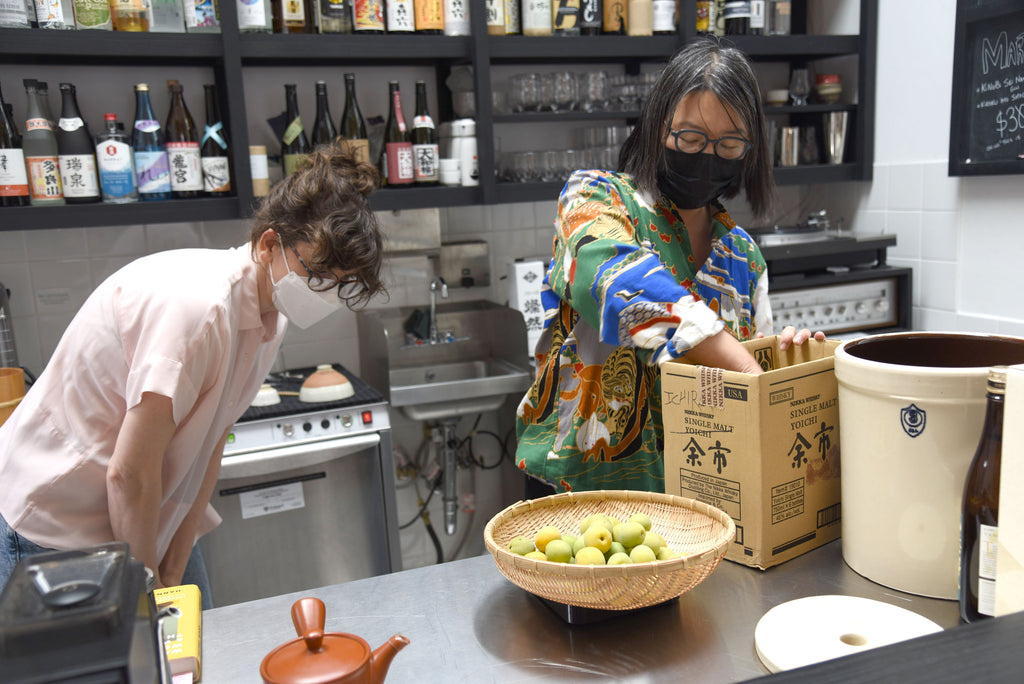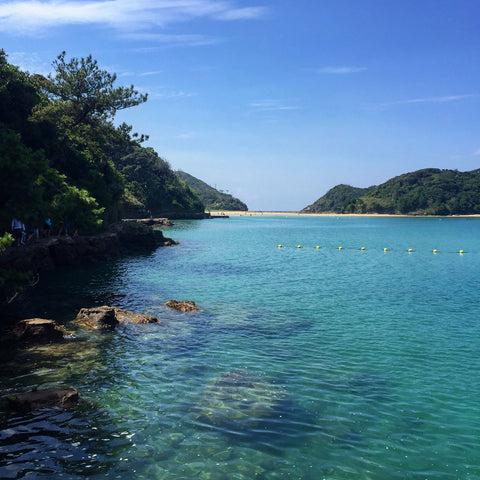
I read Hannah Kirshner's book Water, Wood, & Wild Things on the Greek Island of Ikaria. The gentle breeze, the occasional rooster cawing in the distance, and the sounds of the Aegean Sea was a perfect soundtrack to this book that follows master makers all around Yamanaka, a tiny mountain town in Ishikawa Prefecture. The book is meditative with ink illustrations dotted through its pages, depicting hand crafted sake cups, ducks caught with nets, and sansai (mountain vegetables) harvested by the author. There is both a pleasant rhythm to her writing, and a lot to learn.

That is why I was very much looking forward to our umeboshi-making event with Kirshner upon my return – to meet her, and learn a few things. Having her at Umami Mart in person brought the book to life and Kayoko and I were happy to greet a full house to our store for the umeboshi-making demo and book signing. It turns out the calm energy in her book is a direct reflection of her personality: deliberate, succinct, yet tranquil.

Kirshner came to the shop about two hours before the event to prepare the ume for the demo.

Kayoko and Hannah weighing out the ume to 3 kg.

The ume need to soak for about 2-3 hours prior to pickling, so dirt loosens from the fruit.
At 5pm, guests arrived. After Hannah introduced herself, she read a passage from the book.

A full house!

We then started the umeboshi demo.
After soaking, remove the stems from the ume with a toothpick. The stems are bitter so they must be removed.

Hannah asked for some volunteers to help her de-stem the rest of the fruit.

Then you pack the ume and salt, layer by layer.

For the full recipe, get the book!
After the demo, she showed us some of the pieces she brought back from Yamanaka.

We sipped on sake from Ishikawa Prefecture.

Hannah signed all of our books!

And then we posed for the camera with Hannah.

A week and a half later, I continued the umeboshi project. This is what the ume looked like with weights and a cover.

The next step was to add the shiso. So I picked as much red shiso as I had in the garden (about 20 leaves, although it could probably use more), washed and dried them.

I uncovered the weights off of the ume (which were now submerged in their own juice).

I salted the shiso and placed them in a food safe tea bag holder and buried it into the ume.

Then I poured the shiso juice I squeezed while salting them into the crock.

Finally, I reduced the weight to 3 kilograms and covered it again. The next step is to dry them after waiting for another two weeks.
After two weeks, I uncovered the jar, and was greeted by an unpleasant sight.

Luckily, the white mold was localized to the top of the weight only, and when I removed the weight, the ume were well-submerged and protected in its umesu.

These jewel like ume, absorb the light pink hue from from the red shiso and were tender to the touch.

I reserved the umesu pickling liquid into jars for use later.

I transferred each ume onto a covered drying rack.

I hung the three-tiered rack in the doorway of my house, where it gets dappled light in the morning and afternoon.


By the second day, they started to look slightly leathery, but still tender inside.

I left it out for three whole days and nights right around the summer solstice. The hot, dry weather seemed to be ideal for the ume.
Doesn't this make your mouth water?

On the third day, I put them into jars.

I added umesu into one jar for wet style umeboshi and kept the other umeboshi dry.


I tried one at this stage and it was already very delicious – tart with a meaty texture. It tasted like real deal umeboshi!
Hannah says that these will taste better with time, for up to 5 years. I am planning to store these in a cool, dark place for at least 3 months before trying again.

Umeboshi has always been intimidating to me. Kayoko's mom calls the process mendokusai, or bothersome, which is true if you are looking for fast results. It requires less attention to detail as I thought, but it does require a lot of waiting and patience. I've been harnessing my inner zen, and it's been a meditative process so far that reminds me of Hannah's book.
Thank you Hannah for showing us the way of the umeboshi. We hope to have you back for another reading and demo soon!




Comments (1)
Great experience of learning the culture and steps to making umeboshi. So much craftsmanship, beauty and community spirit in the making.